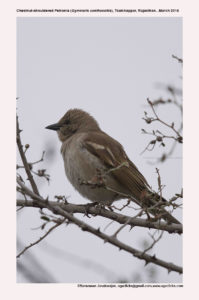Chestnut-shouldered Petronia

Chestnut-shouldered Petronia Gymnoris xanthocollis
Etymology :
- Gymnoris : Greek word gumnos – bare, naked ; rhis –
- Xanthocollis: Greek word xanthos- yellow; Latin word collis– throated
Vernacular Names :Hindi: Raji, Jangli-chiria, Pun: Pila gal chiri, M.P.: Mahoroi, Daidem, Ben: Ban-charai, Te: Adavi-pichike, Konde-pichike, Cheruka-pichika, Mal: Manjatali, Guj: Pahelwanchakli, Raji, Mar: PivlyaKanthachiChimani
Distribution in India: Widespread winter visitor except North, North West and parts of EastIndia.
Description: 12·5–14 cm; 14–20 g. Smallish drab sparrow with comparatively long and slender bill. Male nominate race is mainly olive grey-brown above and pale brown to whitish below, unstreaked; can have faint pale supercilium (often more marked in female); small, rather inconspicuous pale yellow spot on lower throat; chestnut patch on forewing, two prominent white wingbars; tail slightly notched at tip, dark grey with thin paler buffy edges; iris dark brown; bill horn-coloured, becoming black in breeding season; legs grey or grey-brown. Female is like male but duller, lacks yellow throat spot and chestnut forewing; bill yellowish-horn, paler at base. Juvenile resembles female. Race transfuga is paler, more sandy, than nominate..
Habitat: It is found in open country and low hills with trees, river bottoms with trees, and scrub-jungle, also cultivated areas with scattered trees or hedgerows, villages and inhabited areas with gardens. It is found up to 1500 m.
Food habits: It eats plant material, mainly seeds, including those of cultivated cereals, also small berries and nectar (forehead often discoloured golden by pollen); in breeding season also insects, mainly weevils, caterpillars, grasshoppers and ants. Nestlings fed with insects. It forages in trees, but mostly on ground. Gregarious; in pairs and small groups, with larger flocks outside breeding season.
Breeding habits: They breedin Apr–Jul in Afghanistan and mainly Feb–May in India. It lays two broods. It breeds solitary or in small groups. Nest built by female. The nest is a small pad of hair, feathers and grass to being an untidy mass of dry grass, wool and hair, lined with feathers, that fills cavity in which placed, mainly in covered site, including crevice in tree or hole in wall or building, also in old nest of other species. They lay a clutch of 3–4 eggs. The incubation is done by female alone. The chicks are fed by both sexes.